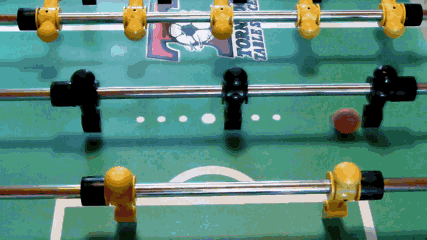By KC Watkins
If you have been watching any foosball video or tournament play and want to learn the Rollover or the Euro Toe shot, the first thing you will have to do is learn how to get the ball out there in front of your man with the foot resting on top of the ball. Warning; this will take Practice.
All Toe Up
In foosball to gain this position is to toe up, or front pin, as the position is called when you have the ball held by the toe of the man (the pointy part of the foot) in front. There is a back pin too, but generally pinning is done out in front of the man.
The front pin is more useful for offense so we’ll be looking at it. There are a few basic ways to execute the move, the corner tap, the brush up, and the back pin sweep are the most common.
The key to getting the foosball pinned no matter which technique you use is consistency, getting that consistent movement. Everyone uses their technique for the same reason; they feel they get a consistent movement, a consistent result, out of it.
So, who’s wrong? No one, really. Find the method that feels right to you, and practice that one. Because practice is the key here.
corner tap
 Assuming you’ve been practicing your tic-tac skills, the corner tap is a move directly from tic-tacing.
Assuming you’ve been practicing your tic-tac skills, the corner tap is a move directly from tic-tacing.
As the ball approaches the center man you try to hit the ball with the forward corner of the man to get it to roll forward.
This technique may take longer to perfect. It takes a certain level of exactness to use the corner of the man effectively. But, it is a game friendly technique, if you make a bad hit the foosball has a tendency to stay within the reach of your men, giving you a better chance of keeping the ball while you learn.
The Brush Up
 The most common method out there of getting the foosball onto the toe of your man is the brush up from a tic-tac. Largely because less perfection is required to get the pin.
The most common method out there of getting the foosball onto the toe of your man is the brush up from a tic-tac. Largely because less perfection is required to get the pin.
The action of the man moving forward will change the direction of the ball’s momentum regardless of exactly where the ball and side of the man meet.
Ideally, you want the foot of the man slightly behind the rod when you make contact. This ensures you enough of a stroke to get the ball moving more forward than sideways. But the forward stroke needs to be just right, not to firm or to soft, to get the momentum of the foosball to change and still stay close enough to catch it.
And of course, this method will work to get a back pin; just, you know, do it backwards.
The Brush Up can also be used standing still. The standing method takes a high level of touch and practice. Because the ball will be pushed away from the man with anything but the slightest of touches.
The Back Pin Sweep
 This move is used by more advance players for a variety of reasons. One main reason is this method uses one smooth movement from beginning to end leaving less room for error, giving you better consistency and ball security.
This move is used by more advance players for a variety of reasons. One main reason is this method uses one smooth movement from beginning to end leaving less room for error, giving you better consistency and ball security.
I have used this example of sweeping from one man to another because it is easier to learn this method, and this is a great exercise in ball control. Once you learn this continuous smooth movement it is much easier to move on to a sweep and catch with the same man.
This is an advanced method but I encourage you to try it out and practice this move at least a few times because moving the ball from a Back Pin to a Front Pin is always a handy skill. Who knows maybe this is the move for you, the one that fits your game.
Regardless of which method you use, I have to say it one more time, the key to consistency and control, is my old nemesis; practice, practice, practice.